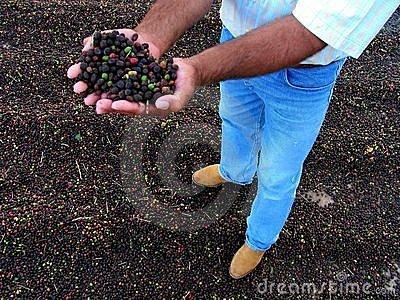A detailed introduction to the characteristics of Costa Rican Yerzaro Coffee.
American beans Costa Rican Ye Salo coffee characteristics specific taste Detailed introduction
The Republic of Costa Rica Independence Day: September 15 (1821) National Day: September 15 (1821) Flag: rectangular, length and width ratio of about 5:3. The flag consists of five parallel wide strips connected together, blue, white, red, white and blue from top to bottom; the red part is painted with the national emblem pattern on the left side. The blue and white colors come from the colors of the original Central American federal flag, and the red part was added when the republic was founded in 1848. National emblem: for the coat of arms. The sun rises from the sea on the shield, symbolizing the dawn of the new age; Balva, Ilasu and Boaz volcanoes are located between the Caribbean Sea and the Pacific Ocean; two white sailboats sail on the sea
Costa Rica grows Arabica coffee trees, which have been improved to make the quality of the beans better and more stable; to facilitate picking, coffee trees are kept at a height of about 2 meters; people eat coffee because the seeds in the fruit are brewed with water. After picking the green coffee beans, the seeds (i.e. coffee beans) can only be roasted after removing the peel, pulp, seed membrane and sunlight exposure. Now some processes can be replaced by machines, which increases the speed of coffee production. However, there is no machine for picking coffee beans, so manual work must be used.
Excellent Costa Rican coffee is known as "extra hard beans" and can grow at altitudes above 1500 meters. Altitude has always been a problem for coffee growers. The higher the altitude, the better the beans, not only because higher altitudes increase the acidity of the beans and thus enhance the flavor, but also because the lower night temperatures at higher altitudes can slow down the growth of trees and thus enhance the flavor of the beans. In addition, due to the high altitude drop caused by sufficient rainfall, coffee tree growth is very favorable.
Among Costa Rica's many excellent producing areas, there is one famous producing area that stands out-Tarrazu, also known as Tarrazu. Tarajoo is renowned in the world of fine coffee and is one of the world's leading coffee producers. In the 2014 COE competition, 17 of the 23 listed beans came from Tarasu. Tarasu is located in the fertile volcanic region of Central America, where there is a humid climate and fertile volcanic soil, abundant rainfall throughout the year, high altitude, and dense forest natural shade, providing a unique growing environment for coffee growth. No pesticides or artificial fertilizers are used during cultivation. Nearly 95% of the coffee beans produced in Tarazhu Alpine are extremely hard beans (SHB), generally grown above 1500 meters above sea level.

Important Notice :
前街咖啡 FrontStreet Coffee has moved to new addredd:
FrontStreet Coffee Address: 315,Donghua East Road,GuangZhou
Tel:020 38364473
- Prev

Description of the taste of the Yega Sheffivoka Coffee washing process in Ethiopia
The taste of Ethiopia's Yega Sheffivoka Coffee washing process describes Yega Sheffield, which is nearly 2,000 meters above sea level and is one of the highest coffee producing areas in the world. Here has been a wetland since ancient times, Yirga means to settle down, Cheffe means wetland, Lake Turkana, Lake Abaya, Lake Chamo bring rich water vapor here. To the valley of fog (Misty val)
- Next

Why are Salvadoran Himalayan coffee beans so popular? what's the price?
Why Salvadoran Himalayan coffee beans are so popular? how much is the price of Salvadoran coffee? Salvadoran coffee ranks alongside Mexico and Guatemala as producers of Asa and Merdo, and is competing with other countries for the top two places in China and the United States. The highlands of origin are large coffee beans of all sizes, which are fragrant and mild in taste. Like Guatemala and Costa Rica, Salva
Related
- Detailed explanation of Jadeite planting Land in Panamanian Jadeite Manor introduction to the grading system of Jadeite competitive bidding, Red bid, Green bid and Rose Summer
- Story of Coffee planting in Brenka region of Costa Rica Stonehenge Manor anaerobic heavy honey treatment of flavor mouth
- What's on the barrel of Blue Mountain Coffee beans?
- Can American coffee also pull flowers? How to use hot American style to pull out a good-looking pattern?
- Can you make a cold extract with coffee beans? What is the right proportion for cold-extracted coffee formula?
- Indonesian PWN Gold Mandrine Coffee Origin Features Flavor How to Chong? Mandolin coffee is American.
- A brief introduction to the flavor characteristics of Brazilian yellow bourbon coffee beans
- What is the effect of different water quality on the flavor of cold-extracted coffee? What kind of water is best for brewing coffee?
- Why do you think of Rose Summer whenever you mention Panamanian coffee?
- Introduction to the characteristics of authentic blue mountain coffee bean producing areas? What is the CIB Coffee Authority in Jamaica?

